
The MCEC Plenary
The crown jewel of the Melbourne Convention and Exhibition Centre is the plenary hall… worthy of a story in itself. So here it is:
Text:/ Andy Ciddor
Every self respecting conference centre has a plenary hall: a place where all of the delegates from a conference can gather together for important plenary sessions such as openings, closings and keynote addresses. Indeed, the word ‘plenary’ means composed of all the members. It also has another, less frequently used meaning: full and complete, not limited in any respect. The Plenary at the recently opened Melbourne Convention and Exhibition Centre takes that second meaning to new heights, depths, and widths.
From its inception, the specifications for the plenary hall have included an extraordinarily diverse range of capabilities and operating modes. Not only is the hall capable of seating 5553 delegates for the plenary sessions of conferences held in the centre, it includes the capability of being divided to become three fully-functional, acoustically-isolated theatres, two of which seat 1507 and the third 2569.
While using operable walls to divide a room is not exactly a ground-breaking innovation, the capability of converting a 1525-seat lower level of the venue from tiered theatrical seating, to flat floor seating, or cleared flat floor, or tiered conference seating, or tiered cabaret floor, or dozens of other possible floor configurations – each in under 10 minutes – is more than a little in advance of what most other plenary halls can do.
The capabilities of the theatre include everything from being a three-tiered theatrical and concert space with full production facilities, to being a two-tiered sports arena with direct access to the loading dock at arena level, or being a flat-floor exhibition or banquet space with direct vehicle access and the capacity to support forklifts and 40-tonne trucks, or being a cabaret venue, or being up to three fully AV-equipped conference rooms. All venue facilities, from air conditioning to communications, can operate either as a single, seamlessly-integrated system, or three autonomous rooms. When divided, the larger central room retains the entire main stage.
WALKING THE MAIN STAGE
The main Plenary stage is 38m wide from wall to wall and 12m from setting line to back wall, with a distance between tormentors of 18m. Supplied by Jands, who designed, installed and commissioned all Plenary staging and lighting systems, the stage has four independent lifts, each a steel platform 18m wide by 3m deep and each carried on six, 18-inch (457mm) diameter Spiralift actuators. The forestage, which can be lowered to form an orchestra pit, consists of a 22m-wide by 2.7m-deep steel platform carried on 10 Spiralifts, and a curved steel platform 19m wide and 2.8m deep, carried on eight more 18-inch Spiralifts. All lifts are designed for a rather hefty 20kPa load (approximately 2000kg/sqm) to carry the fully-laden trucks that can be driven into the venue from the loading dock, when the stage is lowered to auditorium floor level.
Over the stage there are 30 Jands motorised flying battens. Each 24m-wide batten has a load capacity of 500kg and is suspended from a 750kg AC electric winch to provide 9.5m of flying height, which is plenty if you want to hang scenery, but not enough for flown scene changes. The winch system is driven from a Jands-designed Stage Technologies controller.
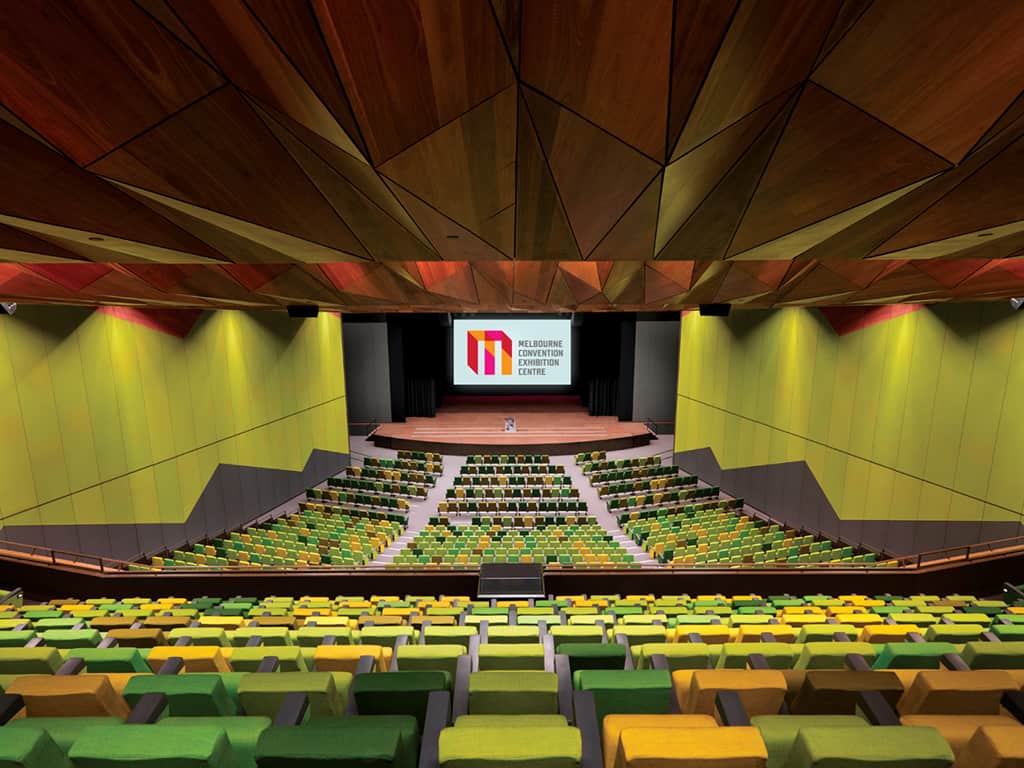
SIDE STAGES
If required, the two side rooms can be provided with 10m-wide, demountable ProStage decks at one metre height and up to eight metres deep. Above both stage areas there are five Jands-supplied flying battens of varying widths, each suspended from a 350kg capacity AC electric winch system and driven by a basic Stage Technologies controller.
IN NEED OF A LIFT
The rear 14 rows of the theatre’s ground level seating comprise a series of independent lifts that can vary in height, and more unusually, deploy or store their seats on demand. Developed by Gala, the Venue seating system stores the seats inside the lift and rotates them up out of the lift and onto the platform when required. Each platform is actuated by a pair of six-inch (152mm) Spiralifts that allow for the adjustment of height from flat-floor to balcony level.
The Venue lift mechanisms were built by Melbourne engineering company Metaltec to Gala Systems design, using Spiralift actuators shipped out from Canada. The multicoloured Camatic Evoke seats (with fold-out A3 writing tablets for conference sessions) are mounted on a beam located underneath the platform deck, hanging like rows of sleeping bats when stored. The mounting beam is mechanically rotated to swing the seats up and over the edge of the platform when they are required. As rotation necessitates a substantial clearance, the control system is programmed to raise alternate lifts to a sufficient height when rotating the seats. Thus 1525 seats can be deployed or removed, and floor levels reconfigured in just 10 minutes, at the click of a mouse or a tap on a touchscreen (once the area has been cleared and secured of course).
While more than capable of supporting the weight of seats and audiences, the Spiralifts in the Venue system are not up to the task of supporting the specified 20kPa loads that could be placed on the lifts by heavy vehicles, so Metaltec developed additional support structures to reinforce the platforms when they are lowered into flat-floor mode.
All audio, video, AV, data and communications systems for the Plenary were designed, supplied, installed and commissioned by Rutledge Engineering with engineering reviews from Marshall Day Acoustics and Lincolne Scott.

HALL THE SOUND YOU COULD WANT
The PA speakers throughout all venues and conference rooms are Nexo. In the Plenary the FOH systems combine Geo-D line arrays with Geo sub cabinets, while PS8s are used as front fills and under balcony fills on the second tier, and PS10s are used for upper balcony fills. Due the vast width of the theatre, four Geo arrays configured as a broad L/R system are required to cover the entire audience. Nexo PS15U and PS15UM wedge monitors are used on stage. All cabinets are driven by Camco Vortex-6 (2 x 3300W) and Tecton 38.4 (2 x 1900W) amplifiers.
When the room is divided into three separate spaces the centre room (Plenary 2) uses only the two middle line arrays. Due to the shape of the two side rooms, additional L/R FOH Nexo Geo arrays must be flown for front coverage. Due to an architectural decision not to break the ceiling line to enable the side room line arrays to be retracted clear of sight lines, these cabinets must be lowered and stowed on dollies when the venue is in full plenary mode. The side room line arrays are also Nexo Geo D and Geo subs, but with a Geo S1230 cabinet slung on the bottom of the array as a front fill. Balcony fills are divided between the rooms, reverting to local control for signal routing and delays.
Each of the three rooms is equipped with a Digico D1 Live digital mixing console linked to three DigiRack and six MiniRacks terminating all inputs and outputs for that room. Of course, all racks are fully networked on a fibre ring for redundancy and interconnectivity, so that any one mixer can handle all routing, mixing and processing. The consoles can be configured as three individual systems or one large three-console system for monitors, recording, and front of house.
The pool of microphones available for use in the Plenary includes Shure UHF-R series wireless handhelds, and lavaliers with wireless bodypacks.
Hearing assistance is provided in each section of the Plenary and both sections of the Grand Banquet room by Chiayo CT800 FM transmitters. Suitably-tuned FM receivers are available on loan from the technical office for the hearing impaired.
COMMUNICATION IS CLEAR
The production communications system is based around a 36-port Clear-Com Eclipse digital matrix with full digital talkback stations on the stage manager’s panel and in the control room for each hall. There are a dozen two-channel wired beltpack units and 10 wireless beltpacks shared between the rooms. There are also facilities to interface the system with other communications systems both within the MCEC and those used by clients such as broadcasters and conferencing facilities.
IN THE BOX SEAT
The technology underlying the reconfigurable floor levels and the stage is the Spiralift from Gala Systems in Canada. Based on the brilliantly simple idea of interlocking two flat metal spirals to form a rigid cylinder, the Spiralift has been used in stage and auditorium applications around the world for over two decades. Its minimal under-stage depth requirements, mechanical simplicity, and the ease of interlocking multiple actuators, make it ideal for use in situations like MCEC on the edge of the Yarra River, where the water table prevents deep excavations for machinery rooms.
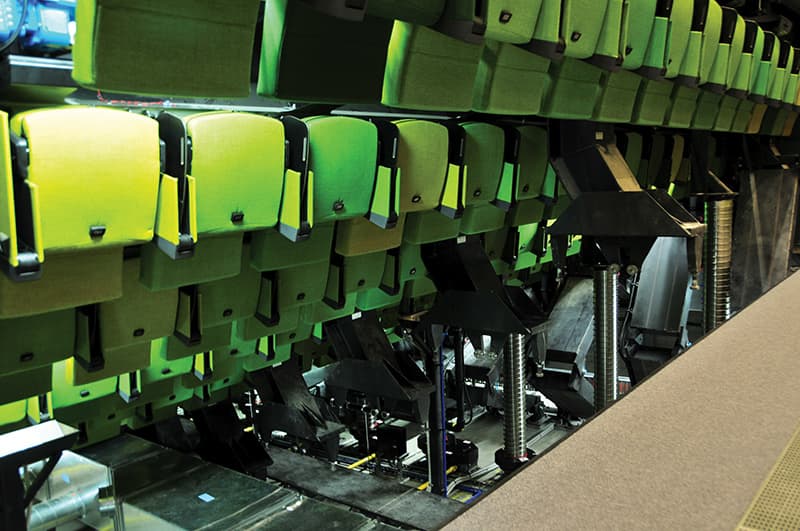
The Bat Cave. A view of the Venue seating when stored beneath the floor platforms. The large metal elephant’s feet reinforce the platforms to carry the weight of the trucks that may be driven on the platforms in their flat floor position.

Mechanically linked pairs of Spiralifts raise and lower the Venue seat platforms, while the Cyberman-like knees guide the paths of the platforms.
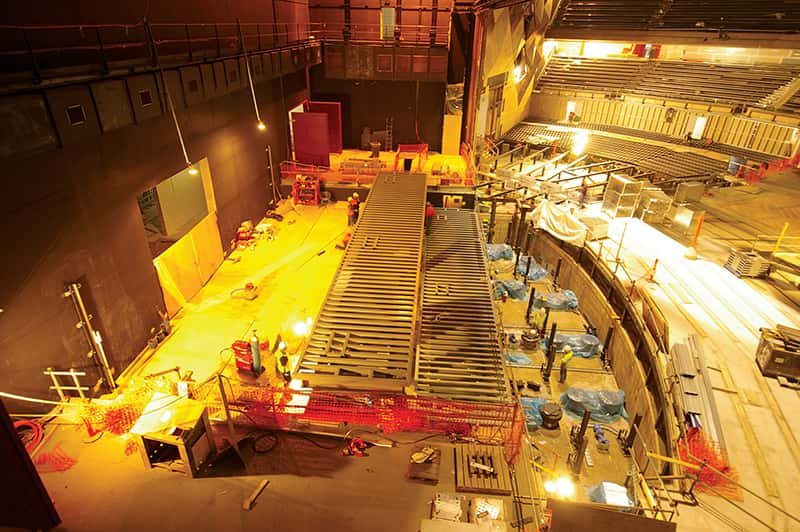
The main stage lifts under construction. Two of the heavily-reinforced stage lift platforms have already been installed. The Spiralifts for the two forestage platforms are also in place.
PLENARY LIGHTS UP
The Plenary’s ability to take on multiple personalities at the drop of a hat necessitates a lighting system with a somewhat confused identity. A big stage with three front of house bridges and excellent site lines, just cries out for big complex productions. It would be great to see thousands of dimmer-per-circuit outlets and vast numbers of power circuits for the hundreds of movers that could so easily be accommodated in the venue.
However, its pretty difficult to justify a rig big enough for grand opera or a U2 concert, when the majority of productions will consist of half a dozen people on the forestage in front of a big video screen showing a company logo or a very big Powerpoint presentation, or perhaps a couple of dozen gowned academics sitting on the stage while a house full of proud mums and dads wait patiently for their kid’s turn to shake hands with the chancellor and receive their parchment.
With the staging and audio and power infrastructure already in place, it will be relatively easy to mount a major production in the Plenary when the occasion arises, but the lighting system in place will probably handle the bulk of productions that will be booked into the venue.
The pool of luminaires for use in all incarnations of the Plenary includes two dozen 1200W (80V) narrow Selecon Pacific zoom profiles, two dozen 750W medium ETC Source Four zoom profiles and two dozen 575W ETC Source Four Junior zoom profiles. There are also two dozen each of Selecon’s 2kW, 1kW and 650W fresnel spots and 20 ETC Source Four Pars. Throw in a Selecon four-colour cyclorama wash system and four of Selecon’s rather useful Rua followspots and you have a modest, but capable rig that will cover plenty of speech nights, AGMs and conference sessions. The dozen Varilite VL500 wash lights and the dozen VL 2500 spot fixtures will add a touch of colour and movement and the sheen of modernity when required.
In an effort to minimise the amount of costly and energy-intensive copper used in cabling the venue, Jands devised a ‘slightly-distributed’ dimming strategy where there are two dimmer rooms, one on either side of the venue. All lighting circuits on the prompt or stage left side of the venue’s mid line go to the prompt side patch panels and dimmer room, while all circuits on the OP or stage right side of the mid line go to the OP patch panels and dimmer room. Each dimmer room terminates 220 circuits of wall-mounted patch panels feeding to five racks of Jands 12 x 2.4kW and 10 racks of Jands 6 x 5kW dimmers. All dimmers receive their DMX512 control feeds via opto-isolated splitters.
In keeping with the philosophy of providing good infrastructure to support future needs, the DMX512 control network is very extensive and capable of extreme flexibility. Built by Jands using Pathway Connectivity’s Pathport Ethernet-based system, the 51 dual-output nodes and the 21 dual-input nodes allow DMX signals to be routed, patched and merged from any point to any point in the network. This will allow any device on the network to be controlled by any of the three ETC Smartfade 2496 consoles or the Jands Vista I3. The house lights are controlled by a Dynalite system.

AUDIOVISUAL ROUNDUP
The AV facilities in the Plenary are part of the totally integrated system distributed throughout the convention centre. Of course there is the standard PTZ camera to monitor or record the activity in the room. Of course, there is a standard all-singing, all-dancing, MCEC lectern for each of the rooms; complete with on-board touchscreen, reading light, keyboard, AMX touch panel to control the room’s facilities, and (where would we be without it) the pop-out cup holder which isn’t the DVD drive draw. However, being larger than the other conference rooms, some of the video facilities in the Plenary are a little larger too. Instead of the more usual Barco CLMHD8+ projector used in the large meeting rooms, the projector for the main screen is an 18k ANSI lumen Barco FLMHD18, while the two side rooms each get a 14k FLMHD14, all of them being native HD resolution (as with every other projector in the MCEC). In fact, there are two Stewart projection screens in the central section of the Plenary Hall: a framed 12.2m (diagonal) screen hung from a flying batten upstage of the proscenium, and a motorised rollup 9.6m (diagonal) screen, suspended over the forestage, for use when the stage space is not accessible. Similar rollup screens are used in the two side rooms.
To provide quality video images to audience members at oblique angles to the main projection screen, there are two additional demountable screens of Barco iLite 6mm-pitch LED tiles that can be positioned on either side of the stage opening.
In addition to all of the usual scalers and format converters feeding the projectors, each of the Plenary control rooms has a DVCAM video recorder, a Digital Betacam player and a Panasonic AV-HS400AE multi-format vision switcher to give presenters an opportunity to produce professional-style presentations.
FULL & COMPLETE
Years of design and planning have gone into making the Plenary full and complete, not limited in any respect and now as its operational staff set about the task of making this come true for hirers on a daily basis, it will be interesting to see how producers, event directors and designers can make use of its unique capabilities.

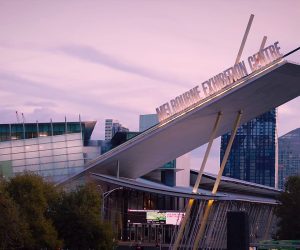





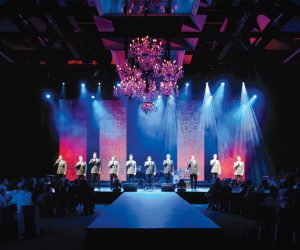






RESPONSES